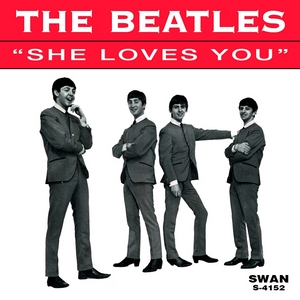Book Excerpt: What Goes On
She Loves You

Recorded July 1, 1963, for the fourth EMI A-side
—in which Lennon and McCartney offer sophisticated chord changes and a mixture of major, minor, and pentatonic modes, and both Harrison and Starr assert imaginative independence, in an intense portrayal of a blending of joy and pain.
“She Loves You” is likely the early Beatles’ most tensile display of supercharged energy, a combination of melodic, registral, harmonic, rhythmic, timbral, and formal precision. This dynamic quality, a goal of the 1963 A-sides, would not often be sought in 1964–1967, but would be recaptured in more diffuse ways in several “throwback” structures in 1968–1969. McCartney has said that the song was inspired by a Bobby Rydell hit; he was referring to “Forget Him,” which has a melodic contour and series of chords—particularly the use of iii and a poignant progression from vi through II7 to iio6/5—clearly borrowed by the Beatles. The sharp chromaticism with ♯2—then the deflating borrowing of the minor mode’s ♭6—of these chords underlines both the ecstasy and pain of the lyrics, and points to the song’s deep jouissance. Mention should also be made of Bobby Vee’s “Take Good Care of My Baby,” covered by the Beatles in 1961–1962, the bridge of which opens with similar melodic scale degrees (particularly in the sustained treatment of 7) and chords as heard in “She Loves You.” The progression in the Vee bridge is the offset doo-wop, IV–V–I–vi, later adapted in the bridges of “I Want to Hold Your Hand,” “I Should Have Known Better,” and many other—principally Lennon—Beatle songs.
“She Loves You” was the first recording made with both George’s new Gretsch Country Gentleman guitar and Ringo’s first Ludwig set; otherwise, John strums his amplified Gibson J-160, and Paul alternates roots and fifths on the Höfner bass in dotted rhythm. George switches pickups eight times through the course of the song, dampening the subversively minor-pentatonic
A closer look at this song’s original chordal relationships reveals even more creativity. First, although the song lies in G major, it opens with an ambiguous E- minor chord, vi, setting an uncertain context for the scene. Then, when the bold II7 chord does not move to V (as it would have been expected to do in all pre-Beatles repertoire) but instead resigns into a plagal IV, the Beatles announce the Lydian II♯ chord that will mark “Eight Days a Week,” “Yesterday,” “You Won’t See Me,” “She’s Leaving Home,” and many other numbers as quintessential Lennon-McCartney creations. The IV leads nicely into a cadential I for the sustaining “yeah,” but this plagal resolution is blurred when George sings a non-triadic sixth scale degree against John’s fifth directly below, and Paul’s first above, creating an added-sixth chord that remains a trademark for a year or so. This combination of first and sixth scale degrees ties together all chords heard thus far, as these are the two tones common to all of them, but, more importantly, sets up a battle between the optimistic G major (“glad”) and its shadow, E minor (“bad”), through the course of the song. We’ve already noted the important emphasis given G and E in the G—F♯—E motto; it’s also the core of the song’s very first three vocal notes, the (025) blues trichord, D—E—G, which are the same as the last three sung pitches—all together in the final chord. These same three pitches are also the ones that call forth the first refrain (2:24–2:26), made more powerful by the insistently repeated notes (the repeated D on “she said she”) that begin it, and the suddenly intense syncopation occurring for the first time in bass and drums (0:26). The strong motivic contrast between first and sixth scale degrees had been discovered in “Do You Want to Know a Secret” and would be mined again in “This Boy,” “I Should Have Known Better,” and “And I Love Her.”
For the ultimate in drawing out tension, an authentic V–I release does not occur before 1:11–1:14, ending the eighth formal element identified in the chart below, directly following the chorus’s tense II–iiø6/5 display. In its final appearance, this moment expands for full appreciation by the one-more-time closing technique, 1:48–2:06, with the final V7 sustained by a caesura so powerful it would not be repeated before “Happiness Is a Warm Gun” (1968) (and then again by Lennon’s “(Just Like) Starting Over” (1980)). The concentrated one-more-time repetitions of “yeah, yeah, yeah” bring reharmonizations of the repeated melodic fragment a step beyond that which had closed “From Me to You.”
Amazingly, after it seems that John and Paul’s vocal octave on I (2:05–2:07) has brought things to a “glad” and perfect close, the coda finds a way to distill the tension further, by telescoping both vi and II7 chords into a simultaneous sonority (2:09–2:12), and then allow it to dissipate in one final, long-held chord comprising the “glad”/“bad” added-sixth blues-trichord combination, complex and longing yet fully consonant. In two minutes and eighteen seconds, the Beatles bring to full boil a harmonic lobscouse of a joyous major mode (that depends as much on diminished iio and minor iii and vi chords as it does on major I, IV, and V), chromaticism and mode mixture, and minor-pentatonic guitar riffs. “She Loves You” may be the only early Lennon–McCartney song that makes “I Want to Hold Your Hand” seem tame in comparison.